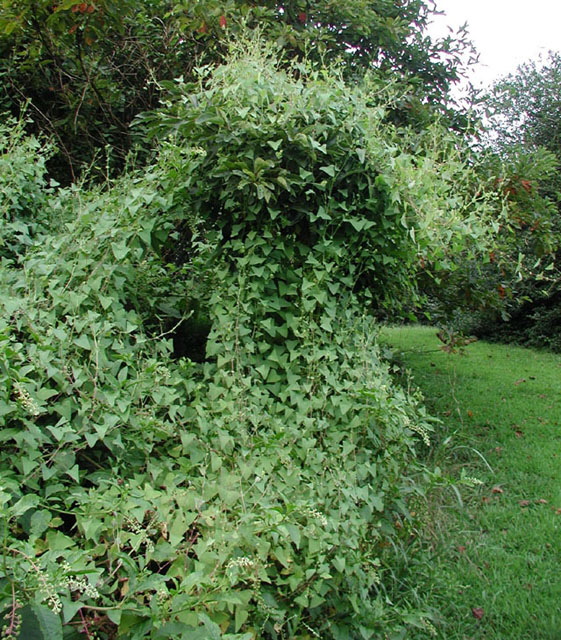|

Les Merhoff
Contact: Jamie Myers, 570-729-7842 With the days turning longer and warmer, people are inclined to spend more time outside, making it the perfect opportunity to keep a lookout for another invasive plant species in the Upper Delaware River valley. Mile-a-minute vine (Polygonum perfoliatum), unfortunately, gets its name from the eerie rate at which this annual vine can grow in a day.Yes, it's true; it can grow up to 6 inches in one day and can reach over 20 feet long in one growing season.This plant is also sometimes known as Asiatic tearthumb, stemming from the prickly stems and leaves that allow the vine to easily climb over surrounding vegetation and form dense, tangled mats that shade out the sun and choke underlying plants.Though this highly aggressive, non-native species should not be confused with the commonly found Arrowleaf tearthumb (Polygonum sagittatum), which is a native species and has leaves in the shape of narrow arrowheads (hence the name!). Mile-a-minute is native to east Asia, and was introduced to Oregon with ship ballast in 1890, bringing it to the United States.Since then it has found its way to Ohio, Virginia, West Virginia, Delaware, Washington D.C., Maryland, New Jersey, New York and Mississippi and more recently to Connecticut and Rhode Island.In 1946 the species was discovered in Pennsylvania in a shipment of rhododendrons and today can commonly be found along streams, in floodplains, along roadsides, in disturbed sites (harvested forests) and open woodlands.The plant seems to have a preference for moist soils.Even closer to home, the National Park Service at Upper Delaware Scenic & Recreational River discovered the species for the first time in 2011 growing in Lackawaxen, PA. in the riverbank area adjacent to the Delaware River just downstream of the Lackawaxen boat access. Mile-a-minute has the potential to overtake native vegetation by smothering seedlings and out competing mature plants for space, nutrients, and sunlight.Trees and other plants could suffer damage due to the weight of this vine.A common characteristic of invasive species is their superior competitive abilities, and this plant is no different; with its fleshy, berry-like, iridescent blue covered seeds that are produced through the entire growing season from June through the first fall frost.These seeds are easily dispersed by water, birds, mammals, and humans and they can also float!These seeds can persist in the localized seed bank for at least 3 years.This annual vine grows extremely rapidly from seed and viable seeds are produced without assistance from pollinators.This prolific seeder has the ability to produce numerous seeds over a long growing season; another advantage of invasive plant species! Mile-a-minute should be easy to spot when you are out and about this spring.Look for its characteristic pale green triangular leaves (approximately 2-3 in. long and 2-3.5 in. wide) alternating along a narrow reddish stem armed with downward pointing barbs and distinctive funnel-shaped leafy structures, called ocreae, surrounding the stem at the nodes.Keep your eye out for it! We at Upper Delaware Scenic & Recreational River are interested in hearing about your findings as well.If you spot mile-a minute vine growing in the Upper Delaware River valley give the Resource Management division a phone call at (570) 729-7842. |
Last updated: February 26, 2015
